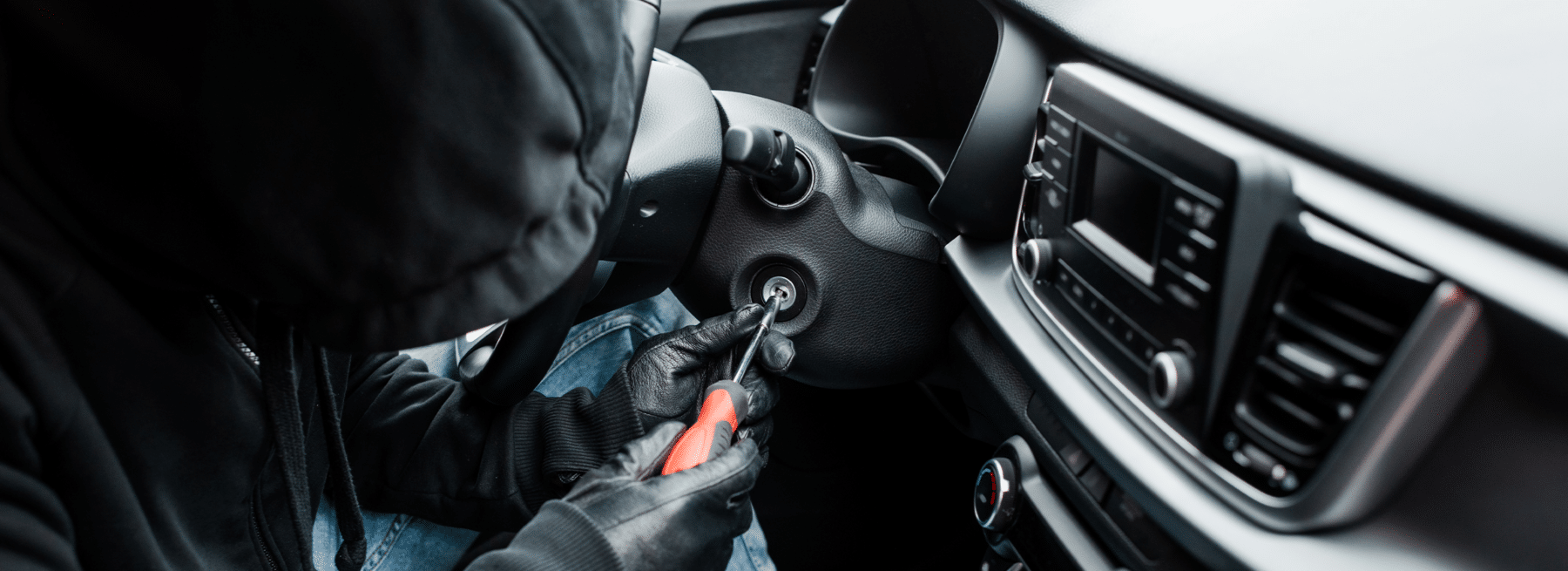The news isn’t good. The U.S. continues to experience a steep increase in catalytic converter and car thefts. Here is the data you must know that drives the need to protect the vehicles in your parking lot or dealership.
Car Theft Statistics
There’s no sugarcoating it. A Car and Driver article reveals car theft skyrocketed in the first three months of 2022 with 12,569 compared to 2021 with 6,692. According to the Insurance Information Institute (III), there have been 246 vehicles per 100,000 people stolen in 2021.
The data is more likely to be worse than what’s reported. The situation is so dire that David Glawe, the president and chief executive officer of the National Insurance Crime Bureau (NICB) testified to the U.S. Senate Committee on the Judiciary.
His testimony talked about the increase in vehicle thefts and carjackings. He urged the Committee to find a way to collect national data on carjackings. Apparently, law enforcement agencies have their own definitions of what’s considered carjacking. So, the reporting is inconsistent.
Car theft isn’t the only problem. There are also catalytic converter thefts that have been plaguing the U.S. for two years. The NICB publication states catalytic converter thefts soared 1,215% compared to 2019 and 203% over 2020. What’s scary is that some large cities have seen carjackings increase in the triple digits.
Catalytic converter theft shows no signs of slowing down. This is a real problem because owners can’t get their vehicles fixed with the limited supply of replacement parts. Unfortunately, these thieves are dangerous as victims have run into violent situations. Thieves shot and killed a deputy in Texas. Legislators know it’s a serious problem and 35 states were either introducing or carrying over legislation that addresses crimes related to vehicle theft.
What’s causing the near record high numbers of vehicle and catalytic converter thefts? It started with the pandemic creating supply chain problems. This led to a shortage of auto parts like computer chips. As new vehicle production fell due to the lack of parts, it drove up the value of new and preowned vehicles. Other factors causing the increase are the economic downturn and criminal justice reform policies that resulted in a reduced police workforce and resources. The NICB Informer publication confirms this.
The Insurance Information Institute article mentions two more factors causing the increase in thefts. These include the loss of juvenile outreach programs and a decrease in public safety programs and budgets.
Even with legislators working on passing laws to curb catalytic converter and auto theft, businesses need to be proactive to reduce catalytic converter and car theft.
4 Ways to Help Prevent Car Theft
No matter the size of your property or what kind of business you have, here are four ways you can strengthen your site security to help minimize car theft and other crimes. The more of these you do, the more layers you’ll have in your security. If crooks circumvent a layer, the other obstacles will slow their efforts. Eventually, they may leave and go search for another site with fewer hurdles.
These car theft prevention tips apply to any business with parking including dealerships, multifamily residential, office buildings, logistics facilities and retail centers.
1. Secure the Perimeter
The least expensive and one of the most valuable security measures is lighting. Verify you have sufficient lighting in the parking lot, garage, sidewalks, and common areas. Someone needs to be responsible for regularly inspecting the entire property to verify all the lights are working and to identify areas for improving the lighting. It’s critical to work with a security specialist as there’s a science to good lighting.
Fencing can do double-duty in stopping organized crime gangs and trespassers. If possible, add a fence or wall around the perimeter. This helps you create one entry and exit point. Of course, this isn’t possible for all businesses.
Don’t forget about the landscaping. Poorly designed and unmanaged landscaping can facilitate crime. It gives intruders a place to hide. Do a review of all the trees, shrubs, bushes, trees, and other greenery for potential hiding spots. Also, look to see if landscaping provides hidden access to the building, blocks views, or hinders lighting.
2. Screen and Train Employees
You can have all the right security solutions, but it means little if your employees do something that creates a gap in your security. Besides, internal theft happens since employees know how to work around security. This why you want to conduct background checks on all new hires. They should also undergo security training.
Your employees provide extra bodies that can watch over the property. However, you want to avoid putting them in dangerous situations. Training will help them learn what to look for and what to do in different situations.
If you have an employee manual, there should be a section on security. This way employees always have access to this information. The manual should be updated as you make changes. Here’s what you might include in an employee manual:
- States employees ensure their badges are visible at all times.
- Provides steps to open and close the building.
- Encourages pairing up when walking to vehicles at night.
- Lists tactics to watch for that may be a precursor to potential criminal activity.
Security training is not a one-time thing for new employees. All employees need to receive refresher training on security. This ensures employees remain vigilant.
3. Educate Customers and Residents
According to the Insurance Information Institute article, a lot of these thefts can be prevented. Apparently, in more than half of the thefts, the key or fob was left in the stolen vehicle. It’s imperative to educate your customers and residents to not leave their keys or fobs in their vehicles.
As vehicles adopt more technologies, they can create more opportunities for theft. Hackers have remotely broken into cars to unlock them or turn on the engine. For example, hackers uncovered significant security flaws with one of the Tesla models. It allowed them to take control of a car. After that happened, Tesla issued a software patch. That’s why it’s important to ensure all vehicles have the latest software. Educate your customers to keep their vehicles’ software up to date.
4. Add Proactive Security Technology
You could hire security guards to patrol the property, but it could be cost-prohibitive. Having security guards watching over the property requires hiring enough bodies. Otherwise, criminals could see gaps in their patrolling and take advantage of it. Besides, security guards can only do so much in a dangerous situation. They’re more for providing a body as a deterrent.
Besides, security guards are human. They do not get anything close to the kind of training law enforcement gets. The possibility of getting hurt or killed is always in the back of their minds. So, they may not do anything to stop a thief especially now with criminals becoming more violent.
That’s why security technologies like video surveillance with remote monitoring are a better option. The advantage of virtual monitoring over security guards and traditional alarm systems is that you have operators safely located in a remote monitoring center without fearing for their lives.
The way remote video monitoring works is that a security vendor installs high-definition video security cameras in strategic locations around the property. It is also possible to use existing cameras, as long as they meet certain specifications.
The appearance of surveillance cameras can add a layer of security in averting criminals. For those that don’t pay attention to the cameras, the trained operators watching the cameras can take action.
The monitoring operators are located in a separate building away from your property. They can check the lighting and landscaping every day and verify they’re properly maintained. Any time they see a potential problem with people coming onto the property, they can issue an audible warning to the intruders through an on-site speaker.
If they don’t turn around and leave the property, then the operator can call the police while tracking the suspects. The operators support the police by providing information, footage, and details to help with the case. Unlike security guards, video cameras with a trained monitoring operator can view the entire property at once.
Traditional security systems are reactive. This means they don’t do anything until something happens. Often, it’s too late. Video surveillance with remote monitoring can help spot things before an event happens or while it’s happening. They have a greater chance of catching criminals.
As previously mentioned, employee theft can be a problem. Video surveillance can help lower the chances of this happening. They won’t be able to hide from the cameras or build a relationship with the monitoring operator.
Another way security cameras come in handy is when customers make a liability claim against your business. If this happens, video analysts can search the footage to piece together what occurred as this video shows a liability claim against a dealership. Liability cases are hard to win without evidence. Thanks to the video, you can have proof that your business isn’t liable.
You might be able to get your insurance premiums lowered after investing in remote video monitoring. It shows the insurance company that you’ve reduced your risk. Many clients have seen remote video surveillance yield an ROI within months.
Every industry has different video surveillance requirements. You want to work with a company that has experience in your industry. When you do, you’ll optimize your investment.
For specific information on security for your industry, select the article of interest:
- How to stop car theft at dealerships
- Why video surveillance is best for retail security
- Do you have any of these 7 security flaws in your apartment building?
- How to secure your office building
To learn more about video surveillance, pick up this guide on Security Systems 101. Please feel free to contact us with your questions.

